Switzerland
by Dan Klebesadal
Reprinted from "Crown Jewels of the Wire", December 1987, page 9
My wife, Janet, and I had a wonderful two week vacation in Switzerland last
summer and I wish to share my findings and observations with you who have an
interest in foreign insulators. My foremost observations, and recommendation, is
for those who love beauty to travel there. Of course, do so when the dollar is a
little stronger.
The country has outstanding beauty from the lakes to the mountains and the
Swiss are VERY congenial, as well as ingenious. I am still amazed at what they
have accomplished in the way of elaborate rail and cog-rail systems which run
through, up, and inside mountains. These achievements, many of which were
completed in the late 1800's, are a credit to those who designed and constructed
these efficient modes of transportation.
Although the scenery captivated a great deal of my attention, my love for
insulators kept me looking out the train windows as we whizzed past pole after
pole of insulators. This got to be a running joke, "Look at that! Oh, he's
looking at insulators again." I got to where I had begun to notice a few
consistencies, but I would always notice yet another new insulator which would
push my interest even further. I began by noticing only brown and white
insulators and soon I began to notice tan, bronze, and finally yellow
insulators. I am not familiar with porcelain insulators, but I knew that a
yellow glass insulator is a prize. So, of all I saw, I began to like the yellows
the most.
After about a week of doing all this watching, I decided that I had better
get busy if I was to take any home with me. This was not easy, for I am used to
getting insulators off abandoned lines. I never did see a downed pole or even
one without wires. Feeling rather discouraged with the prospects, I had to turn
to the Swiss for help.
At one of our stays at a small hotel, we had a very nice couple as our hosts.
Since they were so nice and spoke English well, I thought that I would try out
the topic of insulators on them. Though very puzzled at my interest, they were
very willing to help. The very next day we were off bright and early for the
town's power plant. Our host was familiar with the people there, but they were
also very puzzled. I was led up to the upstairs where the supervisor of the
plant fumbled through hardware in the dark. I was hoping that he would turn on
the light and I would see piles of colored insulators, but instead all there was
to be had were power pieces weighing 40-50 pounds a piece. (Mike Guthrie, don't
ask me what they looked like, I only knew that they would not have traveled well
on and off trains for another week!) This stop was not a total wash though, for
I got a nice translated tour through a Swiss hydroelectric plant.
It wasn't until we got to a larger town that I got really lucky. We went into
a hotel on the main street, told the gentleman at the desk about my interest,
and asked where we might find the local utility company. It was obvious that we
were not guests there, but he and another gentleman put their heads together and
got us pointed in the right direction. When we got there, people were on lunch
(lunch and "tea" are times in the day where all comes to a halt), so
there was little activity.
The ladies at the front counter didn't understand English, and I had
forgotten nearly all the German I knew, so Janet gave her French a try. They
were confused, but got a young supervisor from the back who spoke English very
well. He understood our interest and motioned for us to follow. On the way, I
explained that I was not looking for the giant ones. He said, "O.K.,"
and indicated all that they had left were the white and yellow ones. Janet could
tell how let down I was by this remark, for I floated the rest of the way!
Upstairs was a room full of meters, fuses, wire, lamps, signs, and lots of
insulators! This was the stock room where items were kept in reserve until they
were no longer needed and then they would get buried. When I asked where, he reiterated,
"buried."
Not only was I free to take what I wanted, he went all through the room
grabbing items and offering them to me and explaining the purpose of each. I
liked everything, but I kept thinking of the pain I would put myself through if
I took too much with me. So, I confined my selection to only insulators, yellow
insulators, and a few aluminum pole signs in German. Most of the insulators had
the metal pins/mounts still in them. After trying to turn one off its pin, he
explained that they will never come off. Later trials proved him to be correct.
I now credit the Swiss for their railways and their INSULATOR CEMENT!!
I did get a few other brown ones at another power plant in another city, so I
was very happy, but very weighted down. Throughout all the searches, I could not
believe the help I was provided by these people. They knew what I wanted, but
not why, and they would go out of their way to help. I even went into a gas
station and asked to borrow an oil filter wrench to attempt turning them off (I
hadn't given up yet!) Well, they went and set me up at a work bench with a drill
and a vise so that I could remove the cement. Wow! I don't think that even Mr.
Goodwrench would do that for a foreigner over there. Well, that is my saga and
here are a few of my observations and generalizations about Swiss insulators:
Nearly all the insulators I saw were porcelain. I only saw glass once and
they were clear and resembled a CD 122. Other times, I noticed that near train
stations, the overhead wires were hooked to a glass piece resembling a
"sombrero."
Finding spare insulators was hard because they are being phased out. Due to
the snowfall that occurs there, they are placing telephone and low-voltage lines
underground. And, when they take down a line, they don't stockpile items in the
wild. They are so tidy that everything has a place out of sight. The insulators
I encountered were for telephone and low power. The shape for both was, for the
most part, the same and only the sizes differed. This photo shows the variations
in a particular type. I am told the voltage run on the power insulators is both
220V or 380V.
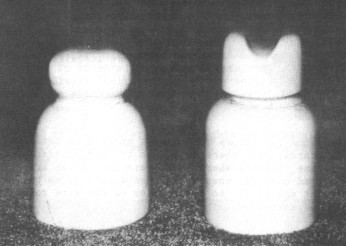
4-7/8" telephone style
5-1/2" power style
|
The way they are mounted to poles depended on whether or power. This picture
shows the typical configuration for the power insulators... |
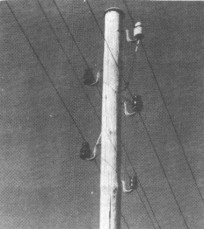 |
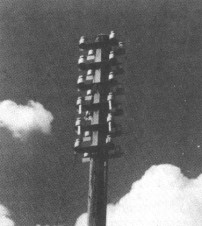 |
...while this is the way in which the telephone insulators are installed. |
The telephone insulators were always mounted on metal crossarms and rarely
were there more than two per crossarm. Only saw one instance where there were
four on an arm. When going around corners, they would even double up on the
crossarms (front and back), so the tension on the wire would be distributed
across two stress points.
The individual pin/brackets for the power pieces were of heavy metal (almost
as heavy as the insulator), and they were threaded on both ends. The auger end
screwed into the pole and the other end had threads more like a bolt. They did
not fit the threads in the insulator and this is where the cement came into
play. While we were at the warehouse mentioned earlier, I did see some mounts
with a curved bracket on the end that would match the curve of a metal pole when
being bolted to it.
Though most of the insulators had slot-tops, the wires were always tied along
side in the wire groove. When I say tied, I mean TIED. I am used to unwrapping a
tie wire the same gauge as the as the main wire and it only takes three wraps to
get it off the main wire and another one wrap to get it off the insulator. The
Swiss use a tie wire of about #18-20 gauge, double it over, wrap it around the
insulator three times, and then reconnect it to the main wire with about 15 very
tight wraps. Below is a picture of a brown insulator on a typical bracket.
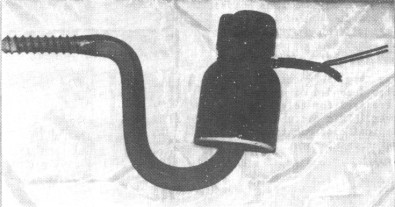
I also noticed that all wooden poles had metal caps on top very similar to
inverted frisbees. These covered the entire surface and diverted rain from
directly seeping into the pole, preventing rot which would cause the screwed-in
mounts to pry out.
All insulators I encountered were double-petticoats and I even saw some
slot-tops that were triples. Below were three different sizes of insulators.
|
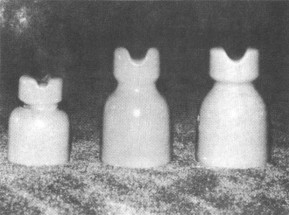
|
| 4" |
5- 7/16" |
5-13/16" |
I only wish that I had done some research prior to the trip to know what I
had been seeing, and also to know if there was anything else I hadn't seen. I
imagine that these insulators are very similar to those found in the bordering
countries of Switzerland. Also, I would be happy to answer and questions of you
readers about my trip.
| 